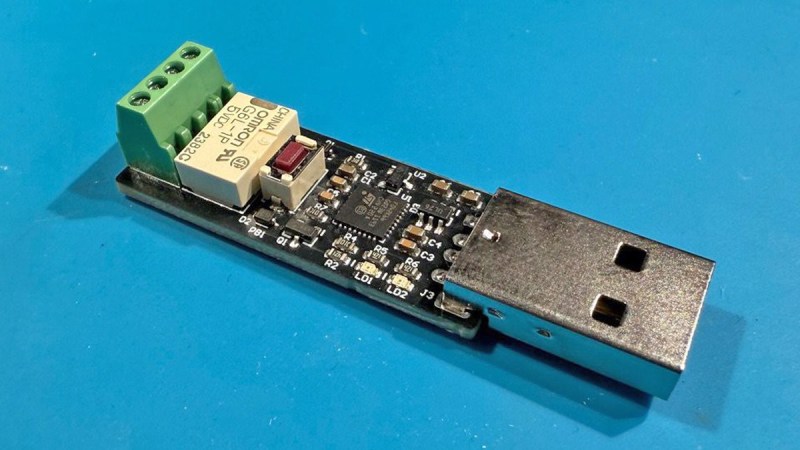Meet the little board that could: [alcor6502]’s tiny USB relay controller, now evolved into a multifunction marvel. Originally built as a simple USB relay to probe the boundaries of JLCPCB’s production chops, it has become a compact utility belt for any hacker’s desk drawer. Not only has [alcor6502] actually built the thing, he even provided instructions. If you happened to be at Hackaday in Berlin, you now might even own one, as he handed out twenty of them during his visit. If not, read on and build it yourself.
This thing is not just a relay, and that is what makes it special. Depending on a few solder bridges and minimal components, it shape-shifts into six different tools: a fan controller (both 3- and 4-pin!), servo driver, UART interface, and of course, the classic relay. It even swaps out a crystal oscillator for USB self-sync using STM32F042‘s internal RC – no quartz, less cost, same precision. A dual-purpose BOOT0 button lets you flash firmware and toggle outputs, depending on timing. Clever reuse, just like our mothers taught us.
It’s the kind of design that makes you want to tinker again. Fewer parts. More function. And that little smile when it just works. If this kind of clever compactness excites you too, read [alcor6502]’s build log and instructions here.
















I wouldn’t call it multifunction device so much as call it multipurpose PCB. The reason being that in order to switch between functions, you must bridge or remove a particular set of components. Unless you like soldering really small things a lot, you’re not going to be switching between functions but rather have multiple PCBs that are built to act as different devices.
It’s the difference between pushing a button to retract the roof of your car versus getting out some wrenches and a manual to carefully remove the roof of your car.
I see what you mean after I studied the underside of the PCB. Yeah shorting solder pads to achieve a certain function makes it single use, unless you care to fire up the good old solder iron and desoldering pump.
Jumpers would have been more appropriate, but make it bulkier. I am still extremely impressed and would want one. A watch dog to power cycler a tiny SBC server is always nice. My ultimate dream would be though a revolver style magazine to swap micro SD cards on an SBC server.
I know network boot would be easier, but how many SBC servers am I going to run for that and what if both hang one time? Okay enough yapping from me ;)
Seems it can be multi purpose if you affix a predetermined pogo pin board or equivalent for the jumpers in what ever housing you want it to be at that time.
I like the idea for my use. I have to buy finished modules, and they often come in packs of three or five, which lead me to have a box of modules in two or four piece bags…
With this I might use all five in a pack in a couple of years.
Nice project, but the writeup here is a bit hyperbolic.
Actually, I had a lot of help from ChatGPT. When I told the AI it would be published on Hackaday, it went really hyperbolic — you should’ve seen the first draft! 😄 It took quite a bit of manual editing to bring it back down to Earth. But hey, being Italian, we have a saying: “Ogni scarrafone è bello a mamma sua!” — which roughly means “Every cockroach is beautiful to its mother.” In other words, I might be a little biased about my project!
I think Andrew meant our writeup rather than yours?
But I think Heidi really thought it was very cool. (And I do too!) No reason to dump on someone’s enthusiasm.
The closest English expression is probably “A face only a mother could love.” Which is somehow even meaner, but at least avoids the implicit comparison to blattella germanica (or any of the other common species).
What if I need fpstructions instead of intstructions?
Sorry, that’s a type error. (Get it?!)
Fixed.
I’ve got one from alcor at HaD EU Berlin!
I have plenty of use for such a device, a simple relay connected to USB MCU
Probably should make a PCB sometime
Like this?
https://vi.aliexpress.com/item/32955376837.html
What’s the max current draw on the relay?
Coil Resistance: 139 Ohms
Sorry, (mech engineer here) But how do actually program/use it?
USB Command Interface
The firmware uses USB CDC (Virtual COM Port) to communicate via serial commands; accepts structured ASCII commands (easy to use in Bash, Shell and Serial Terminal).
Example Commands (Send via Terminal/Script)
Command Function
#S1! Switch ON relay
#P3! Pulse relay for 300ms
#F90! Fan at 90% PWM
#W40! Load controlled with a PWM signal at 40% (B4 or B5 Closed)
#A75! Servo motor positioned at 0°
#Z15000! Set the PWM frequency at 15 KHz
#I! Transmit on the USB the input pin state
#T! Transmit on the USB the fan RPM
#O! Transmit on the USB the PWM percentage of the output